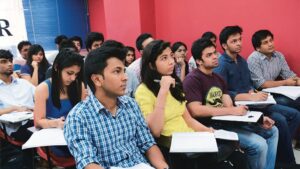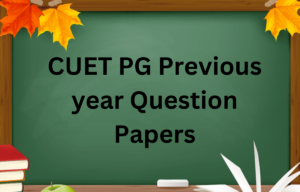The CUET Computer Science exam is held for students who want to join different computer science courses at universities. It helps students get admission based on their performance in the exam, rather than just their school marks. The exam covers topics like math, logic, and sometimes basic computer knowledge. The CUET UG syllabus includes basic subjects like English, Maths, Science, Social Studies, and General Knowledge. All the students who are willing to pursue Computer Science courses can check and download their online CUET UG Computer Science syllabus by simply visiting the official website of the NTA https://cuet.nta.nic.in/.
CUET Computer Science Exam 2026
The NTA [National Testing Agency] will soon release the updated syllabus for the upcoming CUET UG Examination. The Common University Entrance Test or CUET 2026 exam will be conducted in online Computer-Based Test mode. By doing well in the CUET, students can increase their chances of getting into a good university for computer science. Preparing well for the exam by studying the syllabus and practicing sample papers can help students succeed. The CUET is an important step for those who dream of pursuing a career in computer science.
CUET Computer Science Syllabus 2026
The CUET 2026 Computer Science syllabus is expected to cover topics from Class 12 NCERT curricula, including Database Concepts (SQL, relational models), Programming (Python for file and exception handling), and Computer Networks, along with data structures, sorting, searching, and introductory concepts in data handling (Pandas, Matplotlib) and cybersecurity. The exam comprises Section A (mandatory, 15 questions on Computer Science/Informatics Practices) and Section B1 (35 Computer Science questions), with all 35 questions in B1 being compulsory.
CUET Computer Science Unit-Wise Syllabus
The CUET UG Computer Science syllabus is divided into six easy-to-understand units. Unit 1 talks about the basics of computers, like hardware and software. Unit 2 focuses on programming, mainly using C++. In Unit 3, you’ll learn about data structures such as arrays and linked lists. Unit 4 teaches how to manage and store data using databases. Unit 5 is all about networking—how computers share information. Lastly, Unit 6 introduces cybersecurity and how to stay safe online. This CUET syllabus is designed to give beginners a clear and simple introduction to the world of computer science.
Unit 1: Exception and File Handling in Python
- Exception Handling: Syntax errors, exceptions, the need for exception handling, user-defined exceptions, raising exceptions, handling exceptions, catching exceptions, the Try-except-else clause, the Try-finally clause, recovering and continuing with the finally block, and built-in exception classes.
- File Handling: text file and binary file, file types, opening and closing files, reading and writing text files, reading and writing binary files using the pickle module, file access modes.
Unit 2: Database Concepts
- Introduction to database concepts, the difference between database and file system, relational data model: the concept of the domain, tuple, relation, keys – candidate key, primary key, alternate key, foreign Key
- Relational algebra: selection, projection, union, set difference, and cartesian product.
Unit 3: Structured Query Language (SQL)
- Advantages of using Structured Query Language, Data Definition Language, Data Query Language, and Data Manipulation Language, Introduction to MySQL, Creating a database using MySQL, Data Types
- Data Definition: CREATE TABLE, DROP TABLE, ALTER TABLE,
- Data Query: SELECT, FROM, WHERE
- Data Manipulation: INSERT, UPDATE, DELETE
- Math functions: POWER (), ROUND (), MOD ().
- Text functions: UCASE ()/UPPER (), LCASE ()/LOWER (), MID ()/SUBSTRING ()/SUBSTR (), LENGTH (), LEFT (), RIGHT (), INSTR (), LTRIM (), RTRIM (), TRIM ().
- Date Functions: NOW (), DATE (), MONTH (), MONTHNAME (), YEAR (), DAY (), DAYNAME ().
- Aggregate Functions: MAX (), MIN (), AVG (), SUM (), COUNT (); using COUNT (*).
- Querying and manipulating data using Group by, Having, and Order by.
- Operations on Relations – Union, Intersection, Minus, Cartesian Product, JOIN
Unit 4: Computer Networks
- introduction to computer networks, Evolution of networking
- Network types: LAN, WAN, MAN
- Network devices: Modem, Ethernet Card, Repeater, Hub, Switch, Router, Gateway.
- Network Topologies: Mesh, Ring, Bus, Star, and Tree topologies.
- The basic concept of MAC and IP Address Difference between Internet and web
Unit 5: Stack
- Stack (List Implementation): Introduction to stack (LIFO Operations), operations on the stack (PUSH and POP), and its implementation in Python. Expressions in Prefix, Infix, and postfix notations, evaluating arithmetic expressions using stack, conversion of Infix expression to postfix expression
Unit 6: Queue
- Queue (List Implementation): Introduction to Queue (FIFO), Operations on Queue (INSERT and DELETE) and its implementation in Python.
- Introduction to DQueue and its implementation in Python.
Unit 7: Searching
- Searching: Sequential search, Binary search, Analysis of Sequential and Binary Search. Dry run to identify best, worst and average cases.
- Implementation of searching techniques in Python
Unit 8: Sorting
- Overview of sorting techniques, Bubble Sort, Selection Sort, and Insertion Sort. Dry run to identify best, worst, and average cases. Implementation of sorting techniques in Python.
- Hashing: Hash Functions, Collision Resolution, Implementing the Map Abstract Data Type
Unit 9: Understanding Data
- Data and its purpose, collection and organization; understanding data using statistical methods: mean, median, standard deviation, variance; data interpretation; visualization of data.
Unit 10: Database Query using SQL
- Math functions: POWER (), ROUND (), MOD ().
- Text functions: UCASE ()/UPPER (), LCASE ()/LOWER (), MID ()/SUBSTRING ()/SUBSTR (),LENGTH (), LEFT (), RIGHT (), INSTR (), LTRIM (), RTRIM (), TRIM ().
- Date Functions: NOW (), DATE (), MONTH (), MONTHNAME (), YEAR (), DAY (), DAYNAME ().
- Aggregate Functions: MAX (), MIN (), AVG (), SUM (), COUNT (); using COUNT (*).Querying and manipulating data using Group by, Having, Order by.
- Operations on Relations – Union, Intersection, Minus, Cartesian Product, JOIN
Unit 11: Data Handling using Pandas – I
- Introduction to Python libraries- Pandas, NumPy, Chapter 1: Database Query using SQL Chapter 2: Data Handling using Pandas – I Chapter 9: Computer Networks Page | 6 Matplotlib. Data structures in Pandas – Series and Data Frames.
- Series: Creation of Series from – and array, dictionary, scalar value; mathematical operations; Head and Tail functions; Selection, Indexing, and Slicing.
- Data Frames: creation – from the dictionary of Series, list of dictionaries, Text/CSV files; display; iteration; Operations on Rows and columns: add, select, delete, rename; Head and Tail functions; Indexing usingLabels, Boolean Indexing; Styling & Formatting data, Head and Tail functions; Joining, Merging and Concatenations.
- Importing/Exporting Data between CSV files and DataFrames.
Unit 12: Data Handling using Pandas – II
- Descriptive Statistics: max, min, count, sum, mean, median, mode, quartile, Standard deviation, variance.
- DataFrame operations: Aggregation, group by, Sorting, Deleting and Renaming Index, Pivoting.
- Handling missing values – dropping and filling.
- Importing/Exporting Data between MySQL database and Pandas.
Unit 13: Plotting Data using Matplotlib
- Purpose of plotting; drawing and saving the following types of plots using Matplotlib – line plot, bargraph, histogram, pie chart, frequency polygon, box plot, and scatter plot.
- Customizing plots: color, style (dashed, dotted), width; adding label, title, and legend in plots.
Unit 14: Introduction to Computer Networks
- Introduction to Networks, Types of networks: LAN, MAN, WAN.
- Network Devices: modem, hub, switch, repeater, router, gateway
- Network Topologies: Star, Bus, Tree, Mesh.
- Website: Introduction, the difference between a website and webpage, static vs dynamic web page, webserver, and hosting of a website.
- Introduction to Internet, URL, WWW, and its applications- Web, email, Chat, VoIP.
- Web Browser: Introduction, commonly used browsers, browser settings, add-ons and plugins, cookies.
Unit 15: Societal Impacts
- Digital footprint, Etiquettes for Net surfing and for communicating through social media, data protection, Intellectual Property Rights (IPR) and their violation, plagiarism licensing and copyrights, Free and Open Source Software (FOSS), Cybercrime and cyber laws, hacking, phishing, cyberbullying, Overview of Indian IT Act, preventing cybercrime.
- Awareness about health concerns related to the usage of technology like effect on eyesight, physiological issues, and ergonomic aspects.
- E-waste its a hazard and management
Unit 16: Data Communication
- Concept of communication, Types of Data Communication, switching techniques
- Introduction to mobile telecommunication technologies
- Wireless Technologies – Bluetooth, WLAN, Infrared, Microwave
- Communication Media: Wired Technologies – Twisted pair cable, Co-axial cable, Ethernet Cable, Optical Fibre;
- Concept of Channel, Bandwidth (Hz, KHz, MHz) and Data Transfer rate (bps, Kbps, Mbps, Gbps, Tbps)
- Network Protocol: Need for Protocol, Categorization and Examples of protocol, HTTP, FTP, IP, PPP; electronic mail protocol
Unit 17: Security Aspects
- Network Security Concepts: Firewall, Cookies, Hackers and Crackers
- Antivirus and their workings
- Network security threats: Denial of service, Intrusion problems, Snooping, Eavesdropping
- Threats and prevention: Viruses, Worms, Trojan horse, Spam, Cookies, Adware, Firewall, http vs https
Best Books For CUET Computer Science
For CUET UG Computer Science, choosing the right books is important for a strong foundation. These books cover key topics and help build a solid understanding of computer science principles. Here are some recommended books to help with your preparation:
- “Computer Science: A Structured Approach Using C++” by Behrouz A. Forouzan – A great book for understanding the basics of computer science and programming in C++.
- “Introduction to Computer Science Using Python” by Charles Dierbach – Useful for learning programming concepts with Python.
- “Computer Science: An Overview” by J. Glenn Brookshear – Provides a broad overview of computer science topics.
- “Discrete Mathematics and Its Applications” by Kenneth H. Rosen – Essential for understanding mathematical concepts used in computer science.



 Best CUET Coaching in Delhi - Factors De...
Best CUET Coaching in Delhi - Factors De...
 Best CUET Coaching in Noida - Get Top 5 ...
Best CUET Coaching in Noida - Get Top 5 ...
 CUET PG Previous Year Question Papers wi...
CUET PG Previous Year Question Papers wi...







